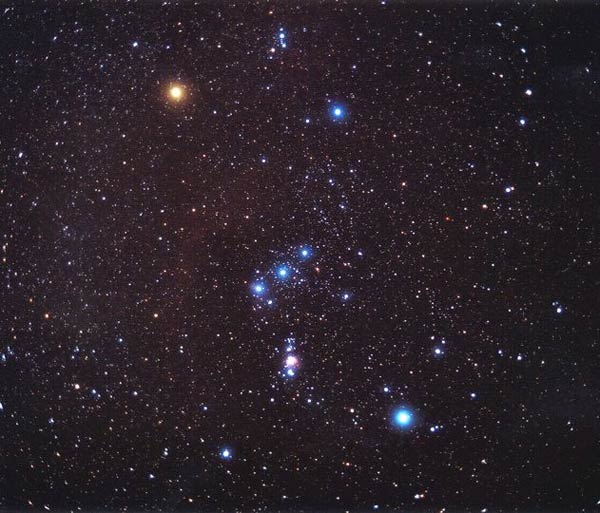New Way to ID Stars in Night Sky Photos

BALTIMORE - A new search engine will soonturn your night sky images into powerful research data and identify thetwinkling objects in them with just the click of a button.
The Astrometry.netdatabase will hunt down and name celestial objects in any amateur photo,pinpoint the region of night sky that was photographed and use the image to expanda detailed database of the cosmos for use by scientists
David Hogg,an astronomer at New York University and leader of the project, showed off thestill-in-development tool at the recent Astrophysics 2020 conference here at Johns Hopkins University's Space Telescope Science Institute.
"Any individual can take a picture ofthe sky, plug it in and learn what stars, galaxiesor other objects are in their image," Hogg told SPACE.com. "It'sfun for people to do this, but more importantly it'll provide data we need tomake that image searchable and useful to scientists."
'Wiki'the sky
The project'sdriving force is astrometry: a branch of astronomy that relies on starpositions to explain how they got there. Although stars may look stationary,they move in a slow "proper motion" from our Earthly vantage point.
"Tounderstand the physics of a star cluster, you need to know the proper motionsof stars in it," Hogg said, mentioning the Beehive Cluster in theconstellation Cancer as an example. "When you run the clock back, you seethe stars came out of some huge formation event."
Get the Space.com Newsletter
Breaking space news, the latest updates on rocket launches, skywatching events and more!
The bestway for astronomers to pin down the celestial motions—as well as keep tabs onthe latest supernovae—is to take many images over time, Hogg explained. Problemis, monitoring the sky tedious and expensive.
Meanwhile,armies of amateurs scour the sky every minute of every day around the world. Butmost don't tag their images with "meta-data" scientists need, such asthe exact time the photo was taken and location of the photographer on Earth atthe time.
Hogg wantsto change that.
"Amateurswith first-class equipment could really revolutionize how we think about doingthis kind of science," he said, noting the search engine's ability to automaticallytag random celestial images with the crucial meta-data.
How itworks
The Astrometry.netprocess begins with an image and software that performs "the most idioticstar identification possible" on it, Hogg said: circling stars and other pointsof light.
Computercode then connects the dots between four stars at a time and compares the patternto those in a massive celestial database. When a good match appears, theWeb-based tool not only visualizes what section of the night sky wasphotographed, but also lists the constellations, objects of interest andprecise celestial longitude and latitude.
"If anamateur takes an image, says, 'Wow, I have a super cool image, what do I dowith it?'," Hogg explained, "we can take that image and turn it intoscience-grade data."
Hogg saiddevelopers are also working toward finding out when a photo was taken byreversing the proper motions of stars in the most up-to-date celestialcatalogues.
"We'rebuilding the catalogue at different times, because in principle there's also abest fit for year," Hogg said.
What'smore, he explained, is that the database won't be a "greedy"repository that simply gathers images and gives nothing back to hard-workingamateur astronomers—some of whom sell prints of their photographs for a livingand worry about copyright issues.
"We wantto give back services in exchange for their help," Hogg said. Suchservices might include recognitionin scientific studies that use the amateur's image, or perhaps linking backto the contributor's Web site when other users stumble upon the image withAstrometry.net's search engine.
Growingpains
Whilecomputer scientists prepare the database for its public debut, tentatively setfor spring 2008, Hogg said the entire operation currently is running off of asimple Web server.
"If wehave tens of thousands of amateur astronomers pushing big images files throughthe server, I'm not sure we could handle that," he said.
To handle theheavy traffic, Hogg said has been speaking with Internet companies that couldhost the service. Eventually, he envisions simple desktop applications for the astro-curiouspublic.
"Welike the idea of a kid in a backyard looking up at the sky, asking 'What isthat?' and having a parent be able to answer their question," he said."All they would need is a decent shot of the part of the sky they'relooking at."
While Hoggexpects most users to queryastronomical images with the database, he said a few will submitnon-astronomy images for fun—perhaps to see if their grandmother's head might create a new constellation.
"Tryingto find your granny in the sky isn't going to work. Our alpha testers havesubmitted some crazy pictures, but we rarely ever get a match," he said."If it's not in the sky, the software won't find it."
- Video: Our Corner of the Cosmos
- Gallery: Amazing Galaxies - Great Backyard Images
- Vote: Most Amazing Galactic Images
Join our Space Forums to keep talking space on the latest missions, night sky and more! And if you have a news tip, correction or comment, let us know at: community@space.com.
Dave Mosher is currently a public relations executive at AST SpaceMobile, which aims to bring mobile broadband internet access to the half of humanity that currently lacks it. Before joining AST SpaceMobile, he was a senior correspondent at Insider and the online director at Popular Science. He has written for several news outlets in addition to Live Science and Space.com, including: Wired.com, National Geographic News, Scientific American, Simons Foundation and Discover Magazine.









